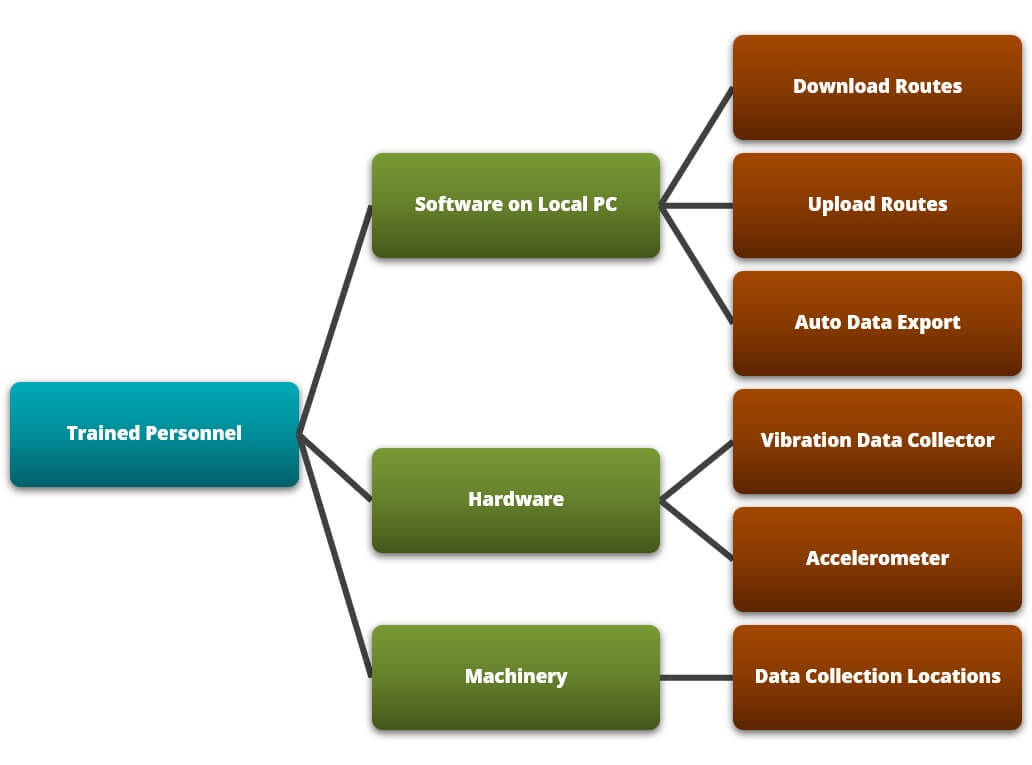Vibration data collection is one of the most important steps in analyzing issues caused by machinery vibration. If done correctly, your analysis, recommendations and reporting become much more accurate. It involves the ability to safely collect vibration data from a given machinery under normal operating condition. This is useful for the analysis of the health condition of the equipment and to provide corresponding recommendations to correct any noted anomalies.
Methods of Vibration Data Collection
There are two primary methods for vibration data collection: manual and automated.
Manual Method
This entails the use of trained personnel to download routes manually from software on a computer onto a data collector. The data collector is carried around the plant (from one machine to the other) and used to collect data from each designated location on a machine. Data is collected on the average interval of once per month, or quarter, while under normal operating condition. After data has been collected, the device is connected to a computer and the routes uploaded back into the software for analysis. As depicted in Figure 1, this method relies on a lot of manual involvement by trained personnel to ensure the process is efficient. Data collected is commonly exported and sent by email to other stakeholders who may not have access to the local computer where the software is installed.

Automated Method
In this method, accelerometers are permanently mounted on machines and terminated into Data Acquisition Units which collect and process data at designated intervals (every minute, hourly, daily, weekly, etc.) depending on the criticality of the machine. As shown in Figure 2, this method has a simplified layout with less personnel involvement in the day-to-day operations of the process. Data collected can be made available instantly online for all stakeholders to view.

Differences Between Manual & Automated Data Collection
The primary differences between the traditional manual method and automated vibration data collection are highlighted below:
- Medium of accomplishing data collection task
- Manual Method: Requires a team of trained personnel, hardware and software.
- Automated Method: Uses a smart system of hardware and software.
- Frequency of routine data collection
- Manual Method: Usually once a month on the average.
- Automated Method: Every minute, hourly, weekly depending on the criticality of the machine.
- Digital acquisition unit
- Manual Method: Mobile handheld data collector (single / double / multi-channel).
- Automated Method: Permanently mounted multi-channel digital acquisition units.
- Accelerometer
- Manual Method: A single handheld accelerometer carried from one machine to the other and moved from one data collection point to the other.
- Automated Method: Permanently mounted accelerometers fixed to the designated data collection points.
- Availability of collected data
- Manual Method: Data is available via the software on the local computer on site after performing a manual route upload. Data can also be sent to other locations by exporting, emailing, and re-importing it into replica databases. Some products allow the use of network versions that can make database sharing possible.
- Automated Method: Data is available automatically to multiple locations using smart applications and the internet. Depending on connectivity, data can sometimes be available in as close as possible to real time.
Benefits of Effective Data Collection
Effective vibration data collection helps you make informed decisions about the health status of any given rotating equipment. By utilizing an efficient data collection method incorporating permanently mounted accelerometers and a centralized data repository, you can move toward developing and optimizing a predictive maintenance program. You will be able to identify faults (without unnecessary intrusion into machinery internals), predict faults, and improve machinery reliability resulting in reduced downtime.
Pingback: Three Purposes of Vibration Analysis | Fluid Life
Pingback: Vibration Monitoring: Sensor Placement Tips | Fluid Life